University Taxation Law Case Study: Fringe Benefit Tax and Income Tax
VerifiedAdded on 2020/05/28
|10
|1748
|51
Case Study
AI Summary
This document presents a detailed analysis of two case studies related to Taxation Law. The first case study focuses on determining the fringe benefit tax (FBT) for an employee using a company car for both personal and business purposes, exploring the application of operating cost and statutory methods for calculating the assessable value. It also addresses the tax implications of additional benefits provided by the employer, such as car parking and honeymoon expenses. The second case study examines the tax consequences for individuals receiving non-monetary benefits, such as gifts and homemade goods, and delves into the distinction between business and hobby activities, particularly in the context of primary production. Furthermore, it clarifies the tax treatment of income derived from barter systems, including the application of GST. The analysis references relevant sections of the FBTAA 1986 and ITAA 1936, along with taxation rulings and court cases to support the conclusions.
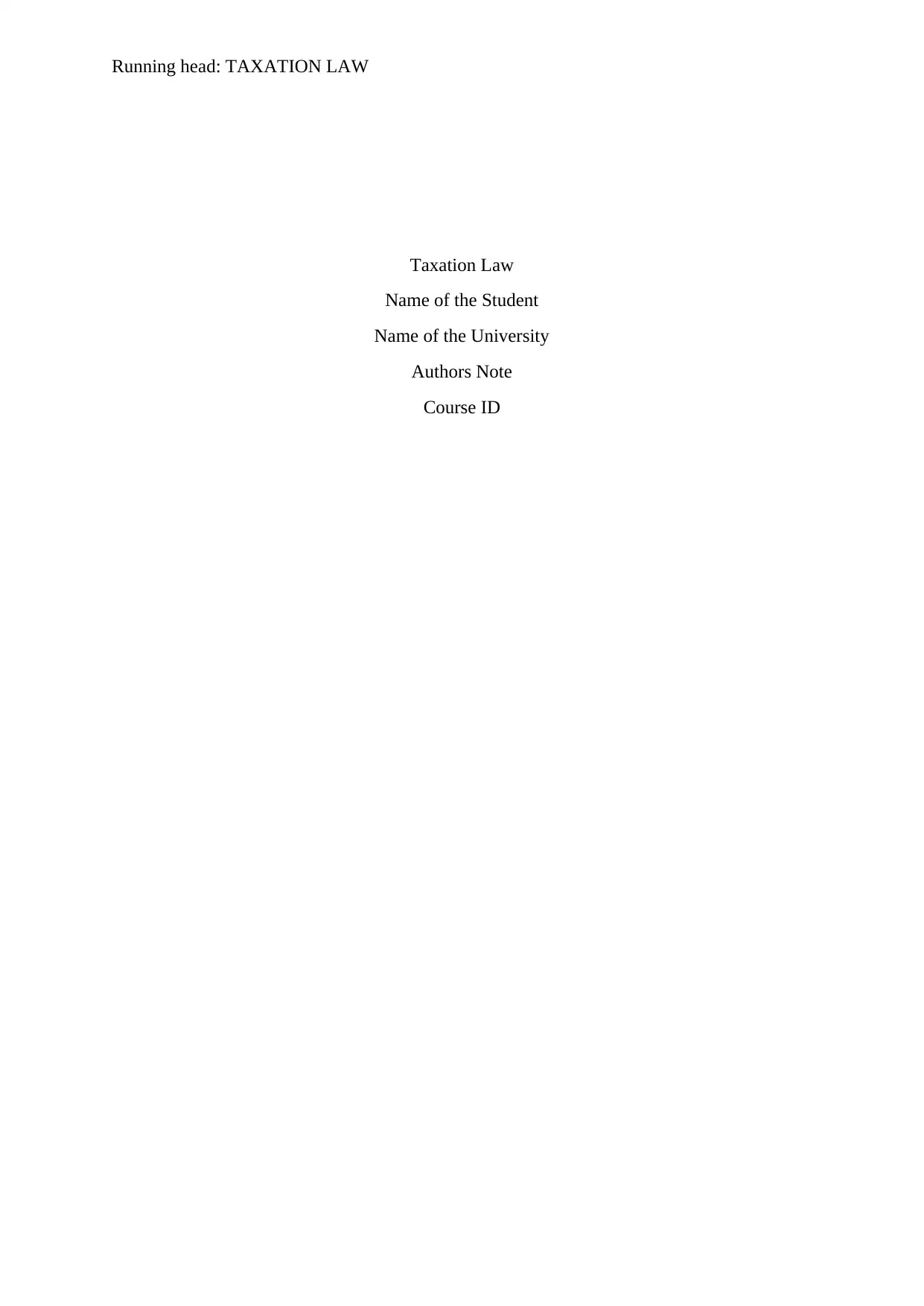
Running head: TAXATION LAW
Taxation Law
Name of the Student
Name of the University
Authors Note
Course ID
Taxation Law
Name of the Student
Name of the University
Authors Note
Course ID
Paraphrase This Document
Need a fresh take? Get an instant paraphrase of this document with our AI Paraphraser
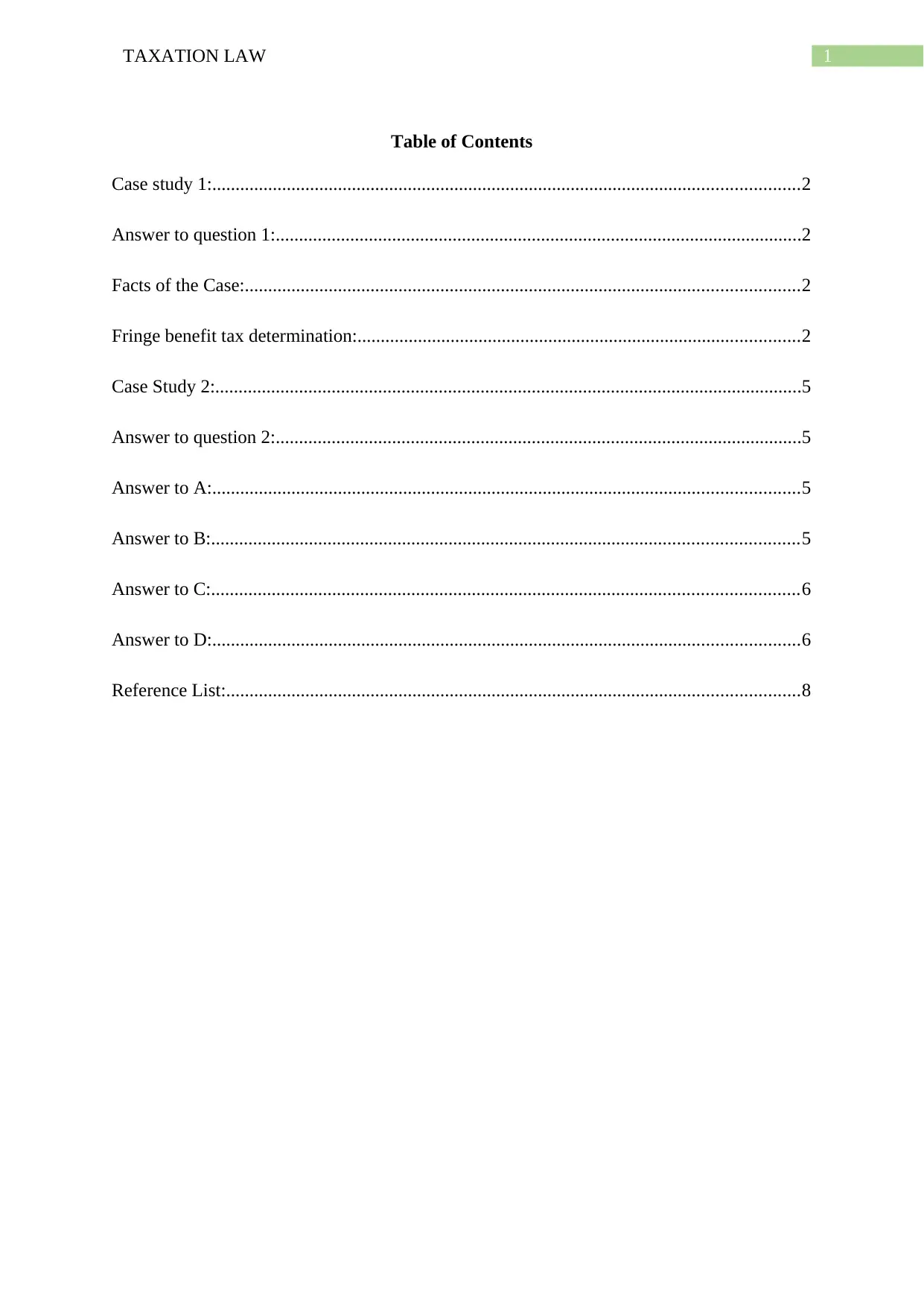
1TAXATION LAW
Table of Contents
Case study 1:..............................................................................................................................2
Answer to question 1:.................................................................................................................2
Facts of the Case:.......................................................................................................................2
Fringe benefit tax determination:...............................................................................................2
Case Study 2:..............................................................................................................................5
Answer to question 2:.................................................................................................................5
Answer to A:..............................................................................................................................5
Answer to B:..............................................................................................................................5
Answer to C:..............................................................................................................................6
Answer to D:..............................................................................................................................6
Reference List:...........................................................................................................................8
Table of Contents
Case study 1:..............................................................................................................................2
Answer to question 1:.................................................................................................................2
Facts of the Case:.......................................................................................................................2
Fringe benefit tax determination:...............................................................................................2
Case Study 2:..............................................................................................................................5
Answer to question 2:.................................................................................................................5
Answer to A:..............................................................................................................................5
Answer to B:..............................................................................................................................5
Answer to C:..............................................................................................................................6
Answer to D:..............................................................................................................................6
Reference List:...........................................................................................................................8
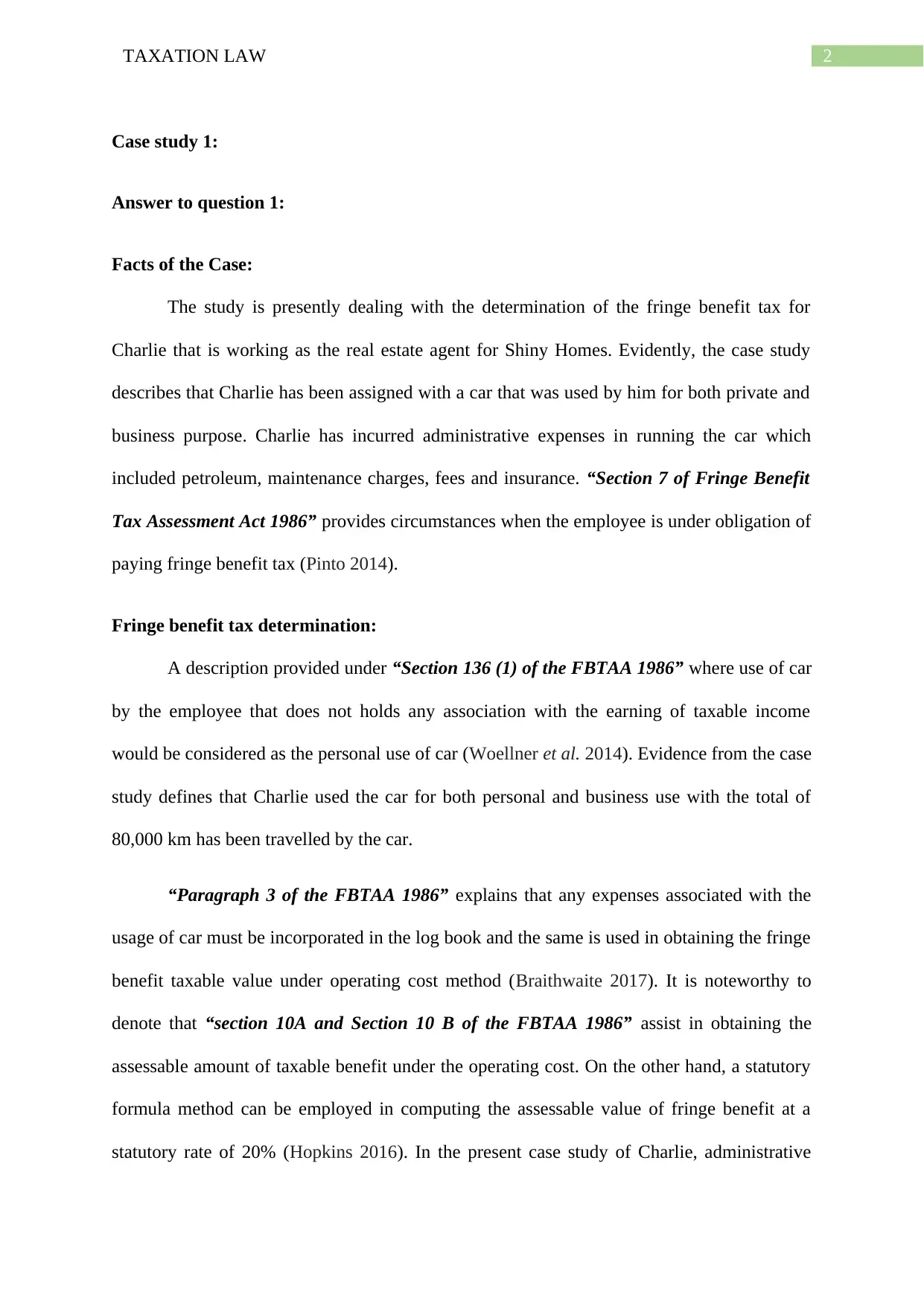
2TAXATION LAW
Case study 1:
Answer to question 1:
Facts of the Case:
The study is presently dealing with the determination of the fringe benefit tax for
Charlie that is working as the real estate agent for Shiny Homes. Evidently, the case study
describes that Charlie has been assigned with a car that was used by him for both private and
business purpose. Charlie has incurred administrative expenses in running the car which
included petroleum, maintenance charges, fees and insurance. “Section 7 of Fringe Benefit
Tax Assessment Act 1986” provides circumstances when the employee is under obligation of
paying fringe benefit tax (Pinto 2014).
Fringe benefit tax determination:
A description provided under “Section 136 (1) of the FBTAA 1986” where use of car
by the employee that does not holds any association with the earning of taxable income
would be considered as the personal use of car (Woellner et al. 2014). Evidence from the case
study defines that Charlie used the car for both personal and business use with the total of
80,000 km has been travelled by the car.
“Paragraph 3 of the FBTAA 1986” explains that any expenses associated with the
usage of car must be incorporated in the log book and the same is used in obtaining the fringe
benefit taxable value under operating cost method (Braithwaite 2017). It is noteworthy to
denote that “section 10A and Section 10 B of the FBTAA 1986” assist in obtaining the
assessable amount of taxable benefit under the operating cost. On the other hand, a statutory
formula method can be employed in computing the assessable value of fringe benefit at a
statutory rate of 20% (Hopkins 2016). In the present case study of Charlie, administrative
Case study 1:
Answer to question 1:
Facts of the Case:
The study is presently dealing with the determination of the fringe benefit tax for
Charlie that is working as the real estate agent for Shiny Homes. Evidently, the case study
describes that Charlie has been assigned with a car that was used by him for both private and
business purpose. Charlie has incurred administrative expenses in running the car which
included petroleum, maintenance charges, fees and insurance. “Section 7 of Fringe Benefit
Tax Assessment Act 1986” provides circumstances when the employee is under obligation of
paying fringe benefit tax (Pinto 2014).
Fringe benefit tax determination:
A description provided under “Section 136 (1) of the FBTAA 1986” where use of car
by the employee that does not holds any association with the earning of taxable income
would be considered as the personal use of car (Woellner et al. 2014). Evidence from the case
study defines that Charlie used the car for both personal and business use with the total of
80,000 km has been travelled by the car.
“Paragraph 3 of the FBTAA 1986” explains that any expenses associated with the
usage of car must be incorporated in the log book and the same is used in obtaining the fringe
benefit taxable value under operating cost method (Braithwaite 2017). It is noteworthy to
denote that “section 10A and Section 10 B of the FBTAA 1986” assist in obtaining the
assessable amount of taxable benefit under the operating cost. On the other hand, a statutory
formula method can be employed in computing the assessable value of fringe benefit at a
statutory rate of 20% (Hopkins 2016). In the present case study of Charlie, administrative
⊘ This is a preview!⊘
Do you want full access?
Subscribe today to unlock all pages.

Trusted by 1+ million students worldwide
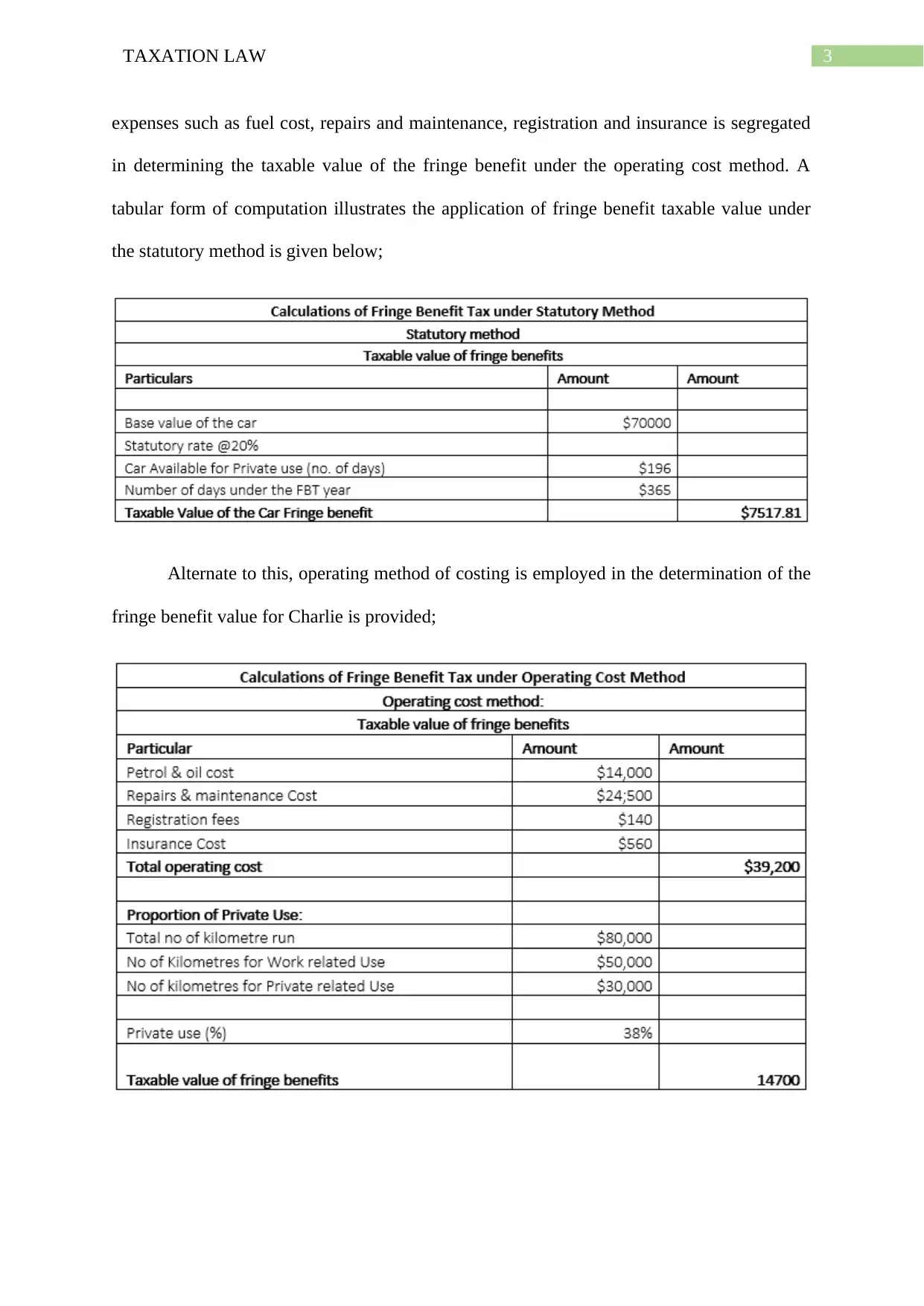
3TAXATION LAW
expenses such as fuel cost, repairs and maintenance, registration and insurance is segregated
in determining the taxable value of the fringe benefit under the operating cost method. A
tabular form of computation illustrates the application of fringe benefit taxable value under
the statutory method is given below;
Alternate to this, operating method of costing is employed in the determination of the
fringe benefit value for Charlie is provided;
expenses such as fuel cost, repairs and maintenance, registration and insurance is segregated
in determining the taxable value of the fringe benefit under the operating cost method. A
tabular form of computation illustrates the application of fringe benefit taxable value under
the statutory method is given below;
Alternate to this, operating method of costing is employed in the determination of the
fringe benefit value for Charlie is provided;
Paraphrase This Document
Need a fresh take? Get an instant paraphrase of this document with our AI Paraphraser
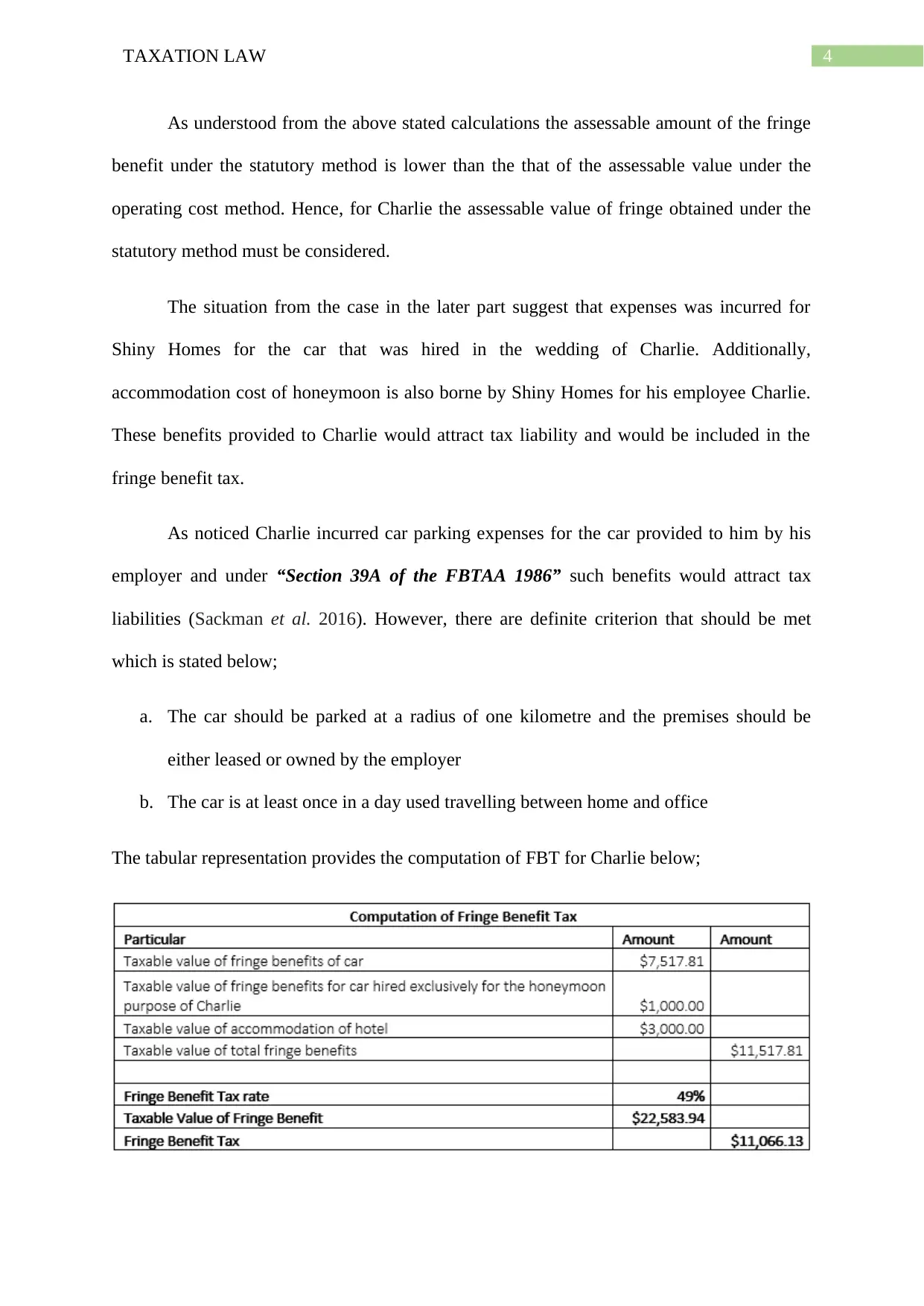
4TAXATION LAW
As understood from the above stated calculations the assessable amount of the fringe
benefit under the statutory method is lower than the that of the assessable value under the
operating cost method. Hence, for Charlie the assessable value of fringe obtained under the
statutory method must be considered.
The situation from the case in the later part suggest that expenses was incurred for
Shiny Homes for the car that was hired in the wedding of Charlie. Additionally,
accommodation cost of honeymoon is also borne by Shiny Homes for his employee Charlie.
These benefits provided to Charlie would attract tax liability and would be included in the
fringe benefit tax.
As noticed Charlie incurred car parking expenses for the car provided to him by his
employer and under “Section 39A of the FBTAA 1986” such benefits would attract tax
liabilities (Sackman et al. 2016). However, there are definite criterion that should be met
which is stated below;
a. The car should be parked at a radius of one kilometre and the premises should be
either leased or owned by the employer
b. The car is at least once in a day used travelling between home and office
The tabular representation provides the computation of FBT for Charlie below;
As understood from the above stated calculations the assessable amount of the fringe
benefit under the statutory method is lower than the that of the assessable value under the
operating cost method. Hence, for Charlie the assessable value of fringe obtained under the
statutory method must be considered.
The situation from the case in the later part suggest that expenses was incurred for
Shiny Homes for the car that was hired in the wedding of Charlie. Additionally,
accommodation cost of honeymoon is also borne by Shiny Homes for his employee Charlie.
These benefits provided to Charlie would attract tax liability and would be included in the
fringe benefit tax.
As noticed Charlie incurred car parking expenses for the car provided to him by his
employer and under “Section 39A of the FBTAA 1986” such benefits would attract tax
liabilities (Sackman et al. 2016). However, there are definite criterion that should be met
which is stated below;
a. The car should be parked at a radius of one kilometre and the premises should be
either leased or owned by the employer
b. The car is at least once in a day used travelling between home and office
The tabular representation provides the computation of FBT for Charlie below;
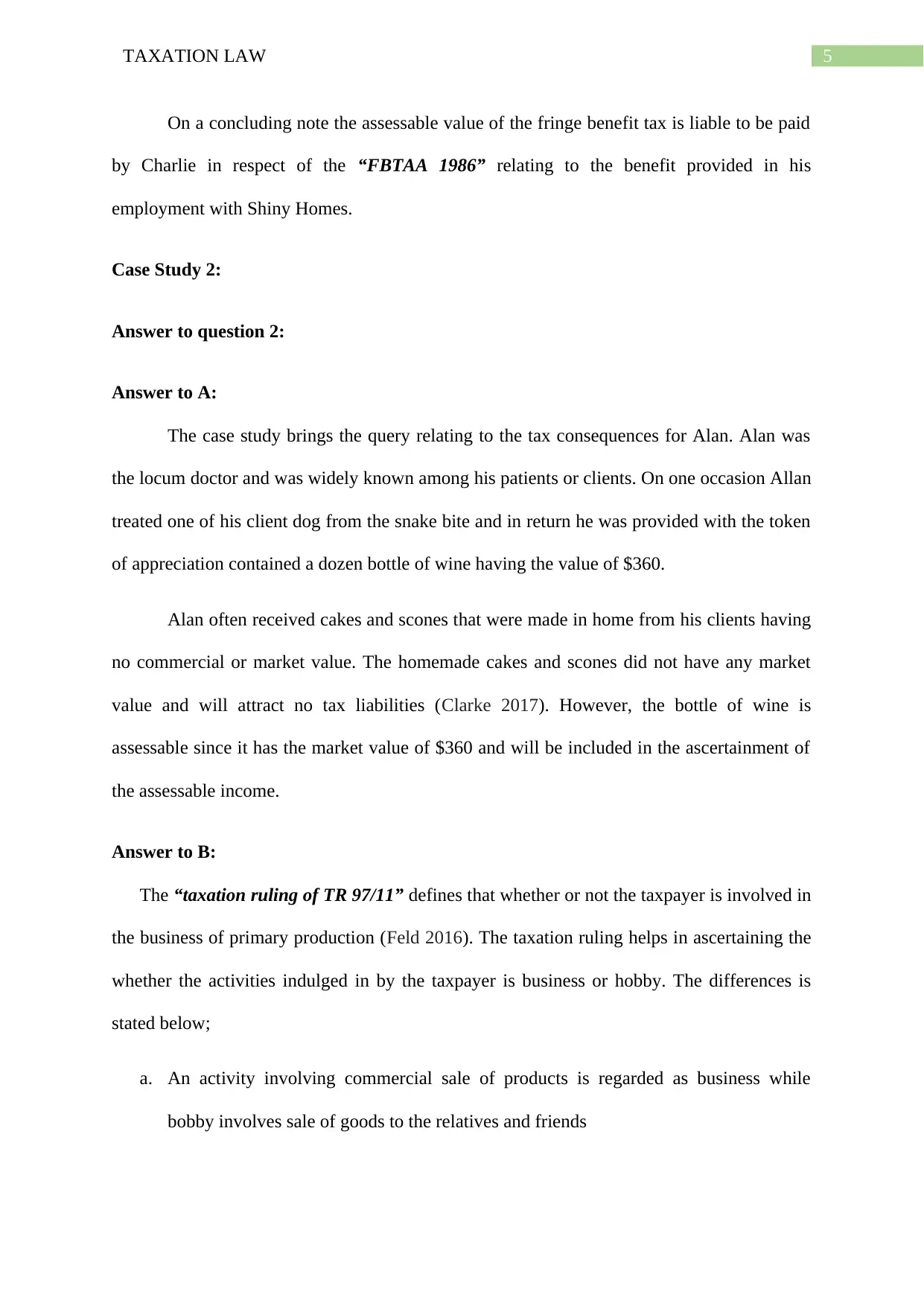
5TAXATION LAW
On a concluding note the assessable value of the fringe benefit tax is liable to be paid
by Charlie in respect of the “FBTAA 1986” relating to the benefit provided in his
employment with Shiny Homes.
Case Study 2:
Answer to question 2:
Answer to A:
The case study brings the query relating to the tax consequences for Alan. Alan was
the locum doctor and was widely known among his patients or clients. On one occasion Allan
treated one of his client dog from the snake bite and in return he was provided with the token
of appreciation contained a dozen bottle of wine having the value of $360.
Alan often received cakes and scones that were made in home from his clients having
no commercial or market value. The homemade cakes and scones did not have any market
value and will attract no tax liabilities (Clarke 2017). However, the bottle of wine is
assessable since it has the market value of $360 and will be included in the ascertainment of
the assessable income.
Answer to B:
The “taxation ruling of TR 97/11” defines that whether or not the taxpayer is involved in
the business of primary production (Feld 2016). The taxation ruling helps in ascertaining the
whether the activities indulged in by the taxpayer is business or hobby. The differences is
stated below;
a. An activity involving commercial sale of products is regarded as business while
bobby involves sale of goods to the relatives and friends
On a concluding note the assessable value of the fringe benefit tax is liable to be paid
by Charlie in respect of the “FBTAA 1986” relating to the benefit provided in his
employment with Shiny Homes.
Case Study 2:
Answer to question 2:
Answer to A:
The case study brings the query relating to the tax consequences for Alan. Alan was
the locum doctor and was widely known among his patients or clients. On one occasion Allan
treated one of his client dog from the snake bite and in return he was provided with the token
of appreciation contained a dozen bottle of wine having the value of $360.
Alan often received cakes and scones that were made in home from his clients having
no commercial or market value. The homemade cakes and scones did not have any market
value and will attract no tax liabilities (Clarke 2017). However, the bottle of wine is
assessable since it has the market value of $360 and will be included in the ascertainment of
the assessable income.
Answer to B:
The “taxation ruling of TR 97/11” defines that whether or not the taxpayer is involved in
the business of primary production (Feld 2016). The taxation ruling helps in ascertaining the
whether the activities indulged in by the taxpayer is business or hobby. The differences is
stated below;
a. An activity involving commercial sale of products is regarded as business while
bobby involves sale of goods to the relatives and friends
⊘ This is a preview!⊘
Do you want full access?
Subscribe today to unlock all pages.

Trusted by 1+ million students worldwide
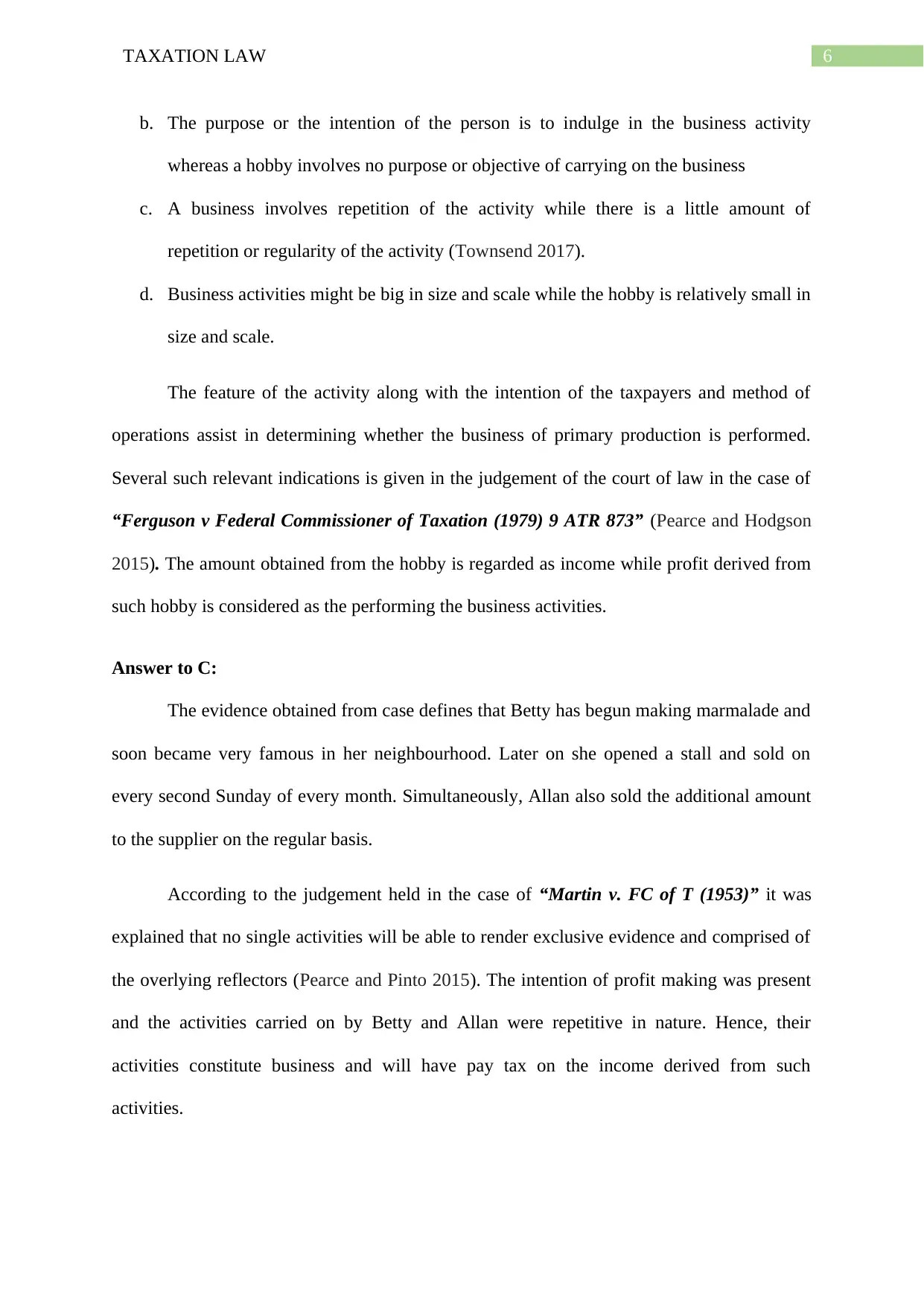
6TAXATION LAW
b. The purpose or the intention of the person is to indulge in the business activity
whereas a hobby involves no purpose or objective of carrying on the business
c. A business involves repetition of the activity while there is a little amount of
repetition or regularity of the activity (Townsend 2017).
d. Business activities might be big in size and scale while the hobby is relatively small in
size and scale.
The feature of the activity along with the intention of the taxpayers and method of
operations assist in determining whether the business of primary production is performed.
Several such relevant indications is given in the judgement of the court of law in the case of
“Ferguson v Federal Commissioner of Taxation (1979) 9 ATR 873” (Pearce and Hodgson
2015). The amount obtained from the hobby is regarded as income while profit derived from
such hobby is considered as the performing the business activities.
Answer to C:
The evidence obtained from case defines that Betty has begun making marmalade and
soon became very famous in her neighbourhood. Later on she opened a stall and sold on
every second Sunday of every month. Simultaneously, Allan also sold the additional amount
to the supplier on the regular basis.
According to the judgement held in the case of “Martin v. FC of T (1953)” it was
explained that no single activities will be able to render exclusive evidence and comprised of
the overlying reflectors (Pearce and Pinto 2015). The intention of profit making was present
and the activities carried on by Betty and Allan were repetitive in nature. Hence, their
activities constitute business and will have pay tax on the income derived from such
activities.
b. The purpose or the intention of the person is to indulge in the business activity
whereas a hobby involves no purpose or objective of carrying on the business
c. A business involves repetition of the activity while there is a little amount of
repetition or regularity of the activity (Townsend 2017).
d. Business activities might be big in size and scale while the hobby is relatively small in
size and scale.
The feature of the activity along with the intention of the taxpayers and method of
operations assist in determining whether the business of primary production is performed.
Several such relevant indications is given in the judgement of the court of law in the case of
“Ferguson v Federal Commissioner of Taxation (1979) 9 ATR 873” (Pearce and Hodgson
2015). The amount obtained from the hobby is regarded as income while profit derived from
such hobby is considered as the performing the business activities.
Answer to C:
The evidence obtained from case defines that Betty has begun making marmalade and
soon became very famous in her neighbourhood. Later on she opened a stall and sold on
every second Sunday of every month. Simultaneously, Allan also sold the additional amount
to the supplier on the regular basis.
According to the judgement held in the case of “Martin v. FC of T (1953)” it was
explained that no single activities will be able to render exclusive evidence and comprised of
the overlying reflectors (Pearce and Pinto 2015). The intention of profit making was present
and the activities carried on by Betty and Allan were repetitive in nature. Hence, their
activities constitute business and will have pay tax on the income derived from such
activities.
Paraphrase This Document
Need a fresh take? Get an instant paraphrase of this document with our AI Paraphraser
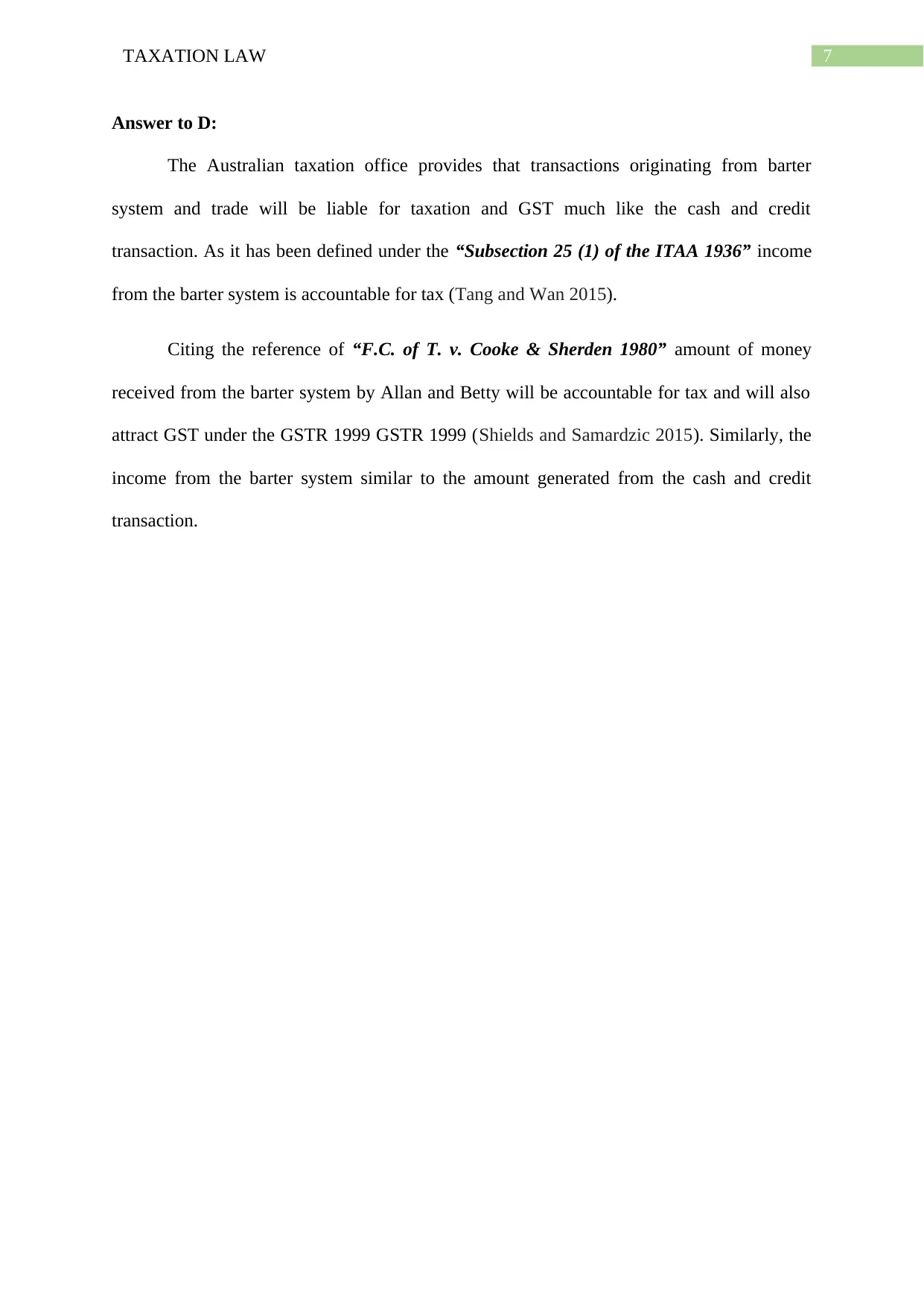
7TAXATION LAW
Answer to D:
The Australian taxation office provides that transactions originating from barter
system and trade will be liable for taxation and GST much like the cash and credit
transaction. As it has been defined under the “Subsection 25 (1) of the ITAA 1936” income
from the barter system is accountable for tax (Tang and Wan 2015).
Citing the reference of “F.C. of T. v. Cooke & Sherden 1980” amount of money
received from the barter system by Allan and Betty will be accountable for tax and will also
attract GST under the GSTR 1999 GSTR 1999 (Shields and Samardzic 2015). Similarly, the
income from the barter system similar to the amount generated from the cash and credit
transaction.
Answer to D:
The Australian taxation office provides that transactions originating from barter
system and trade will be liable for taxation and GST much like the cash and credit
transaction. As it has been defined under the “Subsection 25 (1) of the ITAA 1936” income
from the barter system is accountable for tax (Tang and Wan 2015).
Citing the reference of “F.C. of T. v. Cooke & Sherden 1980” amount of money
received from the barter system by Allan and Betty will be accountable for tax and will also
attract GST under the GSTR 1999 GSTR 1999 (Shields and Samardzic 2015). Similarly, the
income from the barter system similar to the amount generated from the cash and credit
transaction.
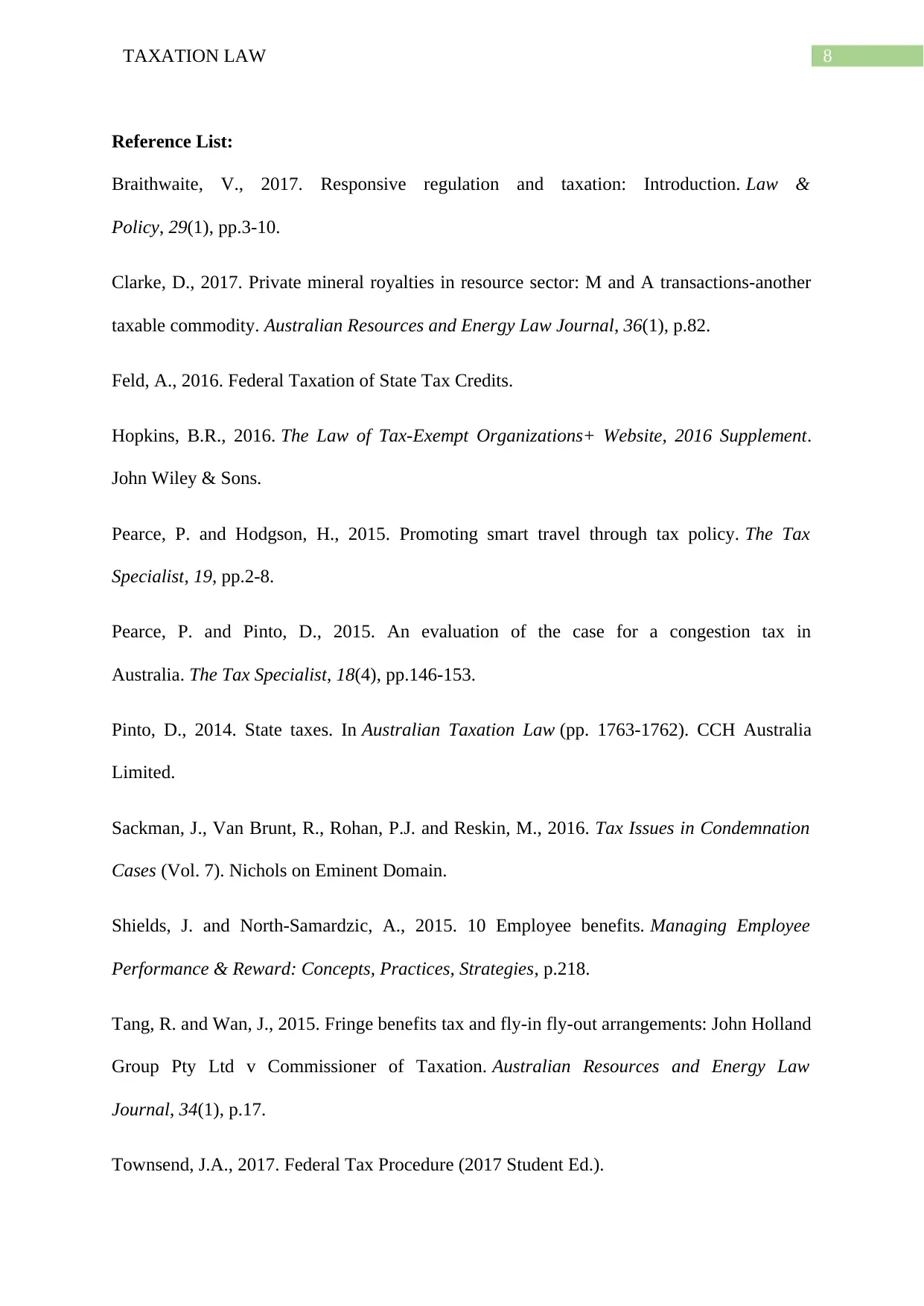
8TAXATION LAW
Reference List:
Braithwaite, V., 2017. Responsive regulation and taxation: Introduction. Law &
Policy, 29(1), pp.3-10.
Clarke, D., 2017. Private mineral royalties in resource sector: M and A transactions-another
taxable commodity. Australian Resources and Energy Law Journal, 36(1), p.82.
Feld, A., 2016. Federal Taxation of State Tax Credits.
Hopkins, B.R., 2016. The Law of Tax-Exempt Organizations+ Website, 2016 Supplement.
John Wiley & Sons.
Pearce, P. and Hodgson, H., 2015. Promoting smart travel through tax policy. The Tax
Specialist, 19, pp.2-8.
Pearce, P. and Pinto, D., 2015. An evaluation of the case for a congestion tax in
Australia. The Tax Specialist, 18(4), pp.146-153.
Pinto, D., 2014. State taxes. In Australian Taxation Law (pp. 1763-1762). CCH Australia
Limited.
Sackman, J., Van Brunt, R., Rohan, P.J. and Reskin, M., 2016. Tax Issues in Condemnation
Cases (Vol. 7). Nichols on Eminent Domain.
Shields, J. and North-Samardzic, A., 2015. 10 Employee benefits. Managing Employee
Performance & Reward: Concepts, Practices, Strategies, p.218.
Tang, R. and Wan, J., 2015. Fringe benefits tax and fly-in fly-out arrangements: John Holland
Group Pty Ltd v Commissioner of Taxation. Australian Resources and Energy Law
Journal, 34(1), p.17.
Townsend, J.A., 2017. Federal Tax Procedure (2017 Student Ed.).
Reference List:
Braithwaite, V., 2017. Responsive regulation and taxation: Introduction. Law &
Policy, 29(1), pp.3-10.
Clarke, D., 2017. Private mineral royalties in resource sector: M and A transactions-another
taxable commodity. Australian Resources and Energy Law Journal, 36(1), p.82.
Feld, A., 2016. Federal Taxation of State Tax Credits.
Hopkins, B.R., 2016. The Law of Tax-Exempt Organizations+ Website, 2016 Supplement.
John Wiley & Sons.
Pearce, P. and Hodgson, H., 2015. Promoting smart travel through tax policy. The Tax
Specialist, 19, pp.2-8.
Pearce, P. and Pinto, D., 2015. An evaluation of the case for a congestion tax in
Australia. The Tax Specialist, 18(4), pp.146-153.
Pinto, D., 2014. State taxes. In Australian Taxation Law (pp. 1763-1762). CCH Australia
Limited.
Sackman, J., Van Brunt, R., Rohan, P.J. and Reskin, M., 2016. Tax Issues in Condemnation
Cases (Vol. 7). Nichols on Eminent Domain.
Shields, J. and North-Samardzic, A., 2015. 10 Employee benefits. Managing Employee
Performance & Reward: Concepts, Practices, Strategies, p.218.
Tang, R. and Wan, J., 2015. Fringe benefits tax and fly-in fly-out arrangements: John Holland
Group Pty Ltd v Commissioner of Taxation. Australian Resources and Energy Law
Journal, 34(1), p.17.
Townsend, J.A., 2017. Federal Tax Procedure (2017 Student Ed.).
⊘ This is a preview!⊘
Do you want full access?
Subscribe today to unlock all pages.

Trusted by 1+ million students worldwide
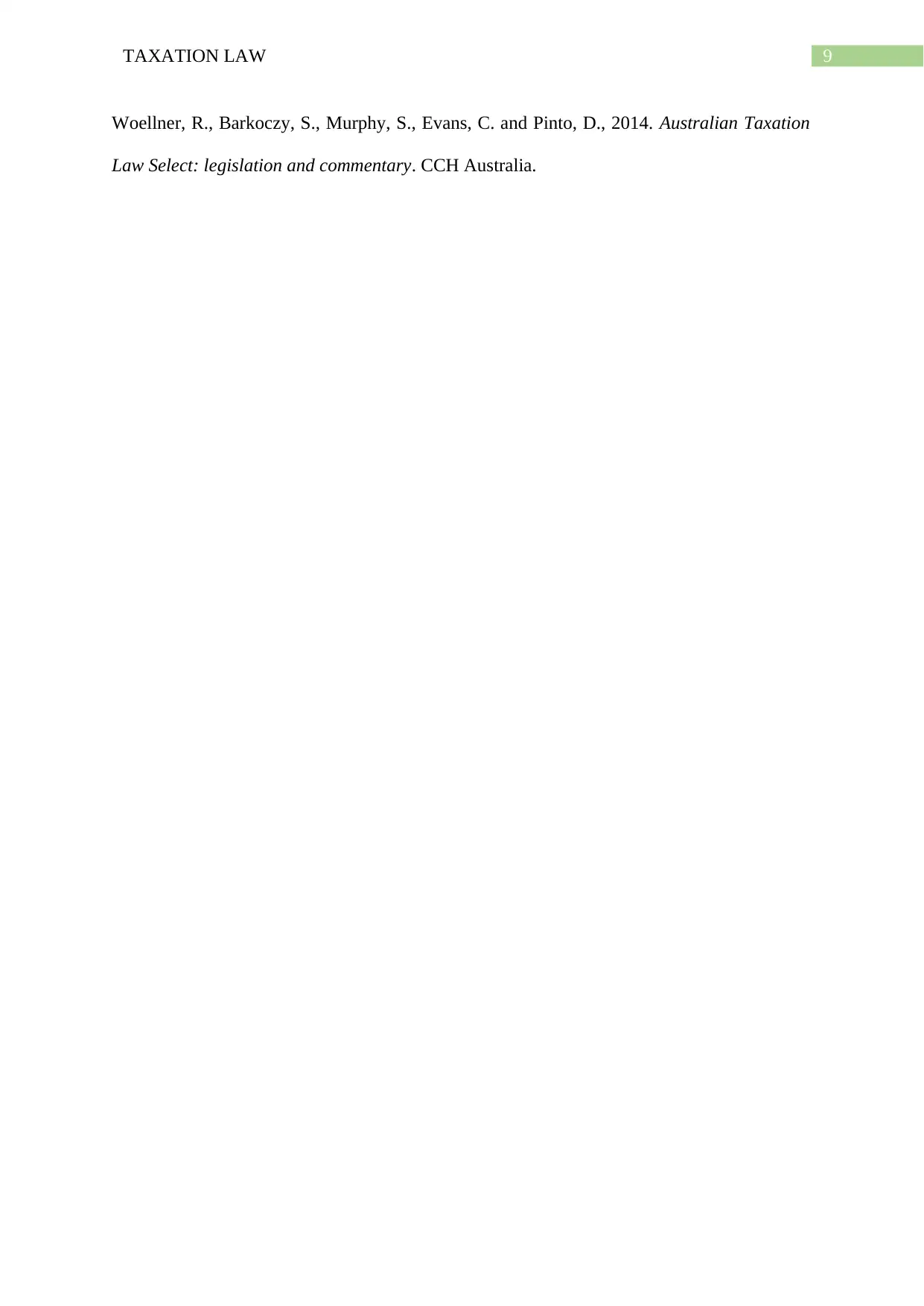
9TAXATION LAW
Woellner, R., Barkoczy, S., Murphy, S., Evans, C. and Pinto, D., 2014. Australian Taxation
Law Select: legislation and commentary. CCH Australia.
Woellner, R., Barkoczy, S., Murphy, S., Evans, C. and Pinto, D., 2014. Australian Taxation
Law Select: legislation and commentary. CCH Australia.
1 out of 10
Related Documents
Your All-in-One AI-Powered Toolkit for Academic Success.
+13062052269
info@desklib.com
Available 24*7 on WhatsApp / Email
![[object Object]](/_next/static/media/star-bottom.7253800d.svg)
Unlock your academic potential
Copyright © 2020–2025 A2Z Services. All Rights Reserved. Developed and managed by ZUCOL.





